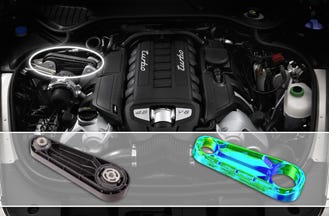Since it must handle the torque of an engine generating 400 or 500 hp, the innovative engine stabilizer developed jointly by ContiTech Vibration Control and materials supplier BASF for the new Porsche Panamera had very high load-bearing requirements. And despite being an underhood part, it also had high aesthetic specs.
October 1, 2009
Since it must handle the torque of an engine generating 400 or 500 hp, the innovative engine stabilizer developed jointly by ContiTech Vibration Control and materials supplier BASF for the new Porsche Panamera had very high load-bearing requirements. And despite being an underhood part, it also had high aesthetic specs.


|
The stabilizer, which is made of a high-strength grade from BASF’s Ultramid CR family of PA resins, will reliably withstand engine torque up to 650 Nm while securing the engine and absorbing sound. A metal part with comparable functionality weighs over 35% more.


Since the stabilizer is visible when the hood is open, ContiTech also worked closely with Porsche designers so that the finished part would have an appealing textured surface. Stefan Wöhler, who is responsible for product development at ContiTech Vibration Control, said his firm built a special mold to achieve the optically high-quality, matte-finish surface.


Perhaps most impressive about the part development is that it went from the digital design domain to series production without any prototypes at all. The challenge was to meet specified functionality and load-bearing criteria within defined spatial constraints. After a few iterations done in BASF’s Ultrasim simulation software package, ContiTech was able to execute a near-series-quality part. No prototypes and minimum optimization cycles translated into significant time and cost savings. Bench trials at both ContiTech and Porsche confirmed the part’s design and functionality.
So, when you are being shown someone’s new four-door Porsche Panamera Turbo, and you are not impressed by its top speed of 188 mph or 0-60 mph time of four seconds flat, prepare to be dazzled when the hood is raised. —[email protected]
About the Author(s)
You May Also Like



